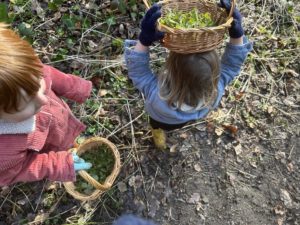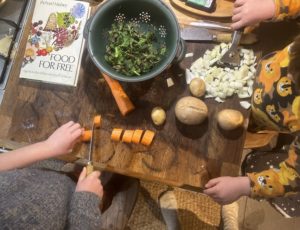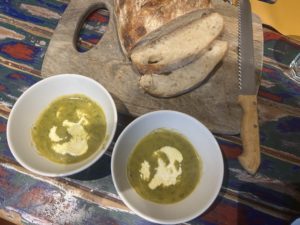Amy Liptrot and sons forage for a spiky lunch.

A first nettle sting is a rite of passage for a young child, quickly followed by learning to identify and avoid them and to find relief by using dock leaves, which usually grow nearby.
My five-year-old is off school sick but after a morning of telly on the sofa he’s perked up. It’s a bright afternoon, the slant of light almost springlike, and a gentle walk in the woods is in order for me and the two boys. I give them baskets and tell them we are going to pick nettles to make soup. They are disbelieving (“it will taste horrible!”) but enthusiastic.
In his 1972 foragers’ guide, Food for Free, Richard Mabey writes: ‘The best time of all for them is when the young shoots are no more than a few inches high. Pick the whole of these shoots’. In the woods, the first soft nettles are growing and we find that just wooly gloves are enough to prevent getting stung, particularly when combined with 5yo’s confident grasping. The toddler insists he wants to gather rocks in his basket rather than nettles. We talk about different kinds of spiky plants: holly, brambles, thistles and they are happy to forage for a while before running around playing “rescues” as I fill the baskets.

Back home, a blanche with boiling water removes the stings. The kids help me peel and chop potatoes and carrots to cook up with the nettles, stirring the pot like a witches’ brew. The nettles give a pleasing intense green which I swirl with cream.
The next day I visit the Centre for Folklore, Myth and Magic in Todmorden to find out what I can about nettles, in dictionaries of Plant Lore, and books on Folk Medicine and Herbal Pharmacopoeia. ‘Eat three feed of boiled young nettles in the springtime and it will keep you free of disease for the rest of the year,’ I read among many mentions of eating nettles as a remedy for rheumatism. I am interested in the idea of the sting of nettles being an ‘anti-poison’ and more modern science suggesting that stings can work to balance inflammation in the body. During the foraging I get a few stings on my cautious thumb and forefinger but don’t find it entirely unpleasant — it’s a slight buzz.
I had hoped that by enjoying being involved in the picking and the cooking, the boys would be prepared to eat and even like the soup but I was too optimistic. They both unequivocally refuse to even taste it. Nevertheless we end the day feeling brighter and healthier than in the morning. We are awakening after winter, stirring with the green shoots and, even without consuming it, nettle soup has been a tonic.
